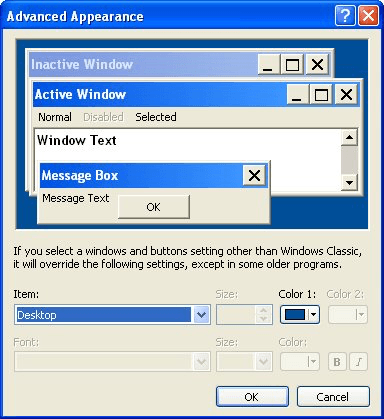Written by Allen Wyatt (last updated November 26, 2020)
This tip applies to Excel 97, 2000, 2002, and 2003
Whenever you select a range of cells to enter data, the active cell is white and all the other cells in the range are a contrasting color. As you enter data and then press the Enter key, that cell becomes the contrasting color and the next cell becomes the active cell and is white. You may wonder how to change the contrasting color to make the selected range stand out more.
The colors used by Excel when you select items are controlled not by Excel, but by Windows. You can change the selection color, but you should understand that when you do so it may affect other programs besides just Excel. The exact steps you follow depend on your version of Windows. If you are using Windows XP, follow these steps:

Figure 1. The Advanced Appearance dialog box.
If you are using Vista, follow these steps instead:
ExcelTips is your source for cost-effective Microsoft Excel training. This tip (8261) applies to Microsoft Excel 97, 2000, 2002, and 2003.

Best-Selling VBA Tutorial for Beginners Take your Excel knowledge to the next level. With a little background in VBA programming, you can go well beyond basic spreadsheets and functions. Use macros to reduce errors, save time, and integrate with other Microsoft applications. Fully updated for the latest version of Office 365. Check out Microsoft 365 Excel VBA Programming For Dummies today!
Excel allows you to associate names with cells or ranges of cells. If you ever want to delete those names, you'll need ...
Discover MoreExcel allows you to display the results of several common worksheet functions on the status bar. The available functions ...
Discover MoreAfter customizing your Excel toolbars, it is a good idea to make a backup of the file that contains the information. ...
Discover MoreFREE SERVICE: Get tips like this every week in ExcelTips, a free productivity newsletter. Enter your address and click "Subscribe."
2021-02-03 12:55:15
Pat
Do you have an answer for Win 10 excel 365? They don't seem to take into consideration people with vision issues.
2016-08-21 18:56:14
nancy golden
My work computer has now been updated to windows 8.1 (soon to be updated again). We run office 2016.
The problem in this article is EXACTLY what I'm looking to solve. Unfortunately, I can't find any context menu. The closest ones I find don't give you the options you showed.
Any ideas? I need to be able to easily look at a spreadsheet and locate the cells that have been "found"...but they're virtually impossible to see.
Thanks.
2016-04-24 12:13:58
JMJ
Thank you for maintaining your so useful tips for those who still use XP!
(I know it's bad, but I just can't refrain :-)
Got a version of Excel that uses the menu interface (Excel 97, Excel 2000, Excel 2002, or Excel 2003)? This site is for you! If you use a later version of Excel, visit our ExcelTips site focusing on the ribbon interface.
FREE SERVICE: Get tips like this every week in ExcelTips, a free productivity newsletter. Enter your address and click "Subscribe."
Copyright © 2025 Sharon Parq Associates, Inc.
Comments